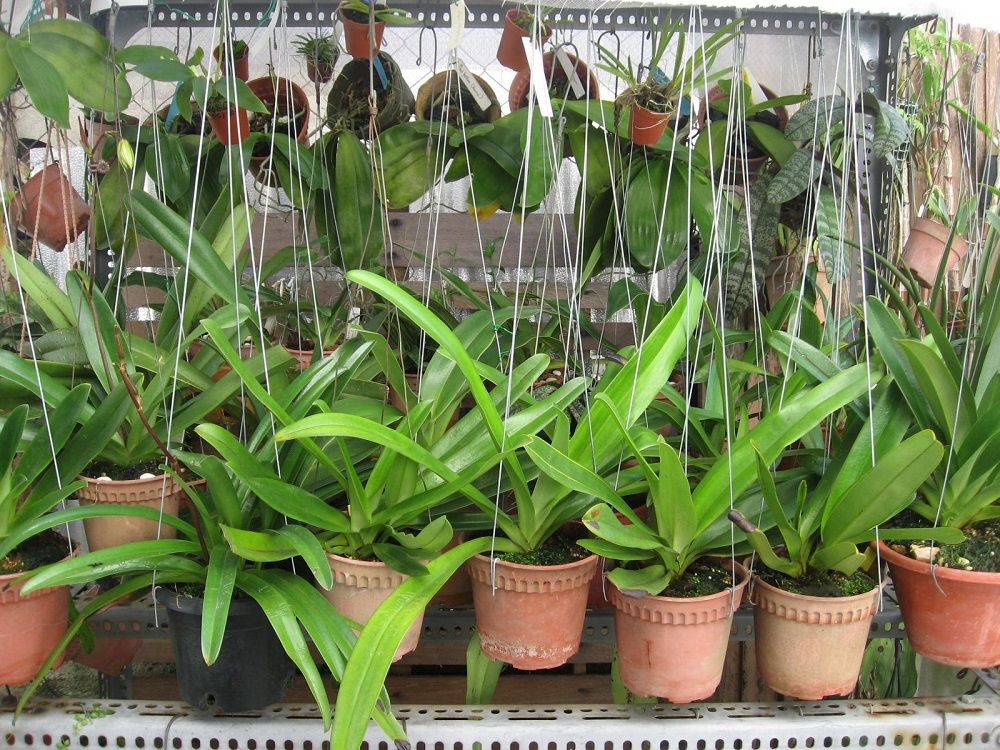papheteer
Well-Known Member
All plants are different. So much variability even among plants from the same flask. Maybe you've got an 'easy' sandie. Take good care of it.

Nice plants and awesome roots!
I would love to know EXACTLYOf all of them, my Paph. sanderianum has the best root systemD) how you are growing the sandie. mix, pot, heat, feed, light, pH, etc. etc. Please

Nice plants and awesome roots!
I don't want to take over this thread but I have a question. I have 15 paphs, all but 2 are species. Of all of them, my Paph. sanderianum has the best root system, the roots are growing out the bottom of the pot even. No other paph of mine has roots like that sanderianum. I thought that sanderianum was supposed to be slow and hard to grow, why does it have the best root system?

If supplementing K-Lite with ammonium nitrate is a good idea, how much ammonium nitrate should be used if you are currently using 1/4 tsp. K-Lite/gallon of RO water? Would you do this every time you fertilize with K-Lite?
Would supplementing with urea be advisable?
Can ammonium sulfate be substituted for ammonium nitrate? Ammonium nitrate does not seem to be readily available. Probably because it is used by terrorists to make explosives.
It's great to learn from anecdotes of experienced growers. I was curious about NO3 vs NH4, so I did a bit of reading. There are quite a lot of research in horticulture about the effect of different types of N sources. Some plant species prefer NO3, and others prefer NH4. Some plants don't care. And these two sources of N have opposing effects on rhizosphere pH environment (due to fairly complex physiology). Some plants have an optimum mix of the 2 source.
The following experiment is not with Paphs, but with Phal hybrid, but there is a pretty dramatic effect.
http://hortsci.ashspublications.org/content/43/2/350.short
I think the main article is not accessible for everyone (contact me if you need it), so here is the summary.
He grew phal hybrid in 100% sphag or in bark-based mix (i.e two different pH). Then used fertilizer with varying proportion of NO3 (0, 25, 50, 75, 100%). There is a fairly linear relationship between aspects of growth and the increasing NO3. With more NO3, the overall leaf size is larger, time to flowering is shorter. Also # of flowers, flower size, inflorescent length, flower stem diamter is larger with more NO3. In other words, most measurements of short-term performance improves with increased percentage of NO3, and 100% NO3 is the best for this experiment. This occured in both acidic sphag moss media or less acidic bark media.
A couple of caveats are that Phals could be quite different from Paphs. However, in a couple other monocots (Colocasia esculanta and Zea mays), they seem to prefer higher proportion of NO3. Also the experiment uses fairly high concentration of fertilizer. With lower concentrations which most of us are using, the source of N may not have such a dramatic effect.
Also there is something called ammonium toxicity, which is not probably an issue with low concentration. I'm not completely sure about this mechanism, but NH4 does inhibit K absorption in some plants.
Probably these are a part of the reasons why MSU (and K-lite) uses NO3 as N source, right?
Does most people think NH4 is the go for Paphs, and if so, why are MSU and Klite using NO3?
I am way behind on reading this thread, but I do have an issue with that statement, as the first batch of K-Lite was manufactured in December of 2011, and the first jars shipped did not reach the users before January of 2012.I switched to K-lite in Oct. 2011. So I used it for almost 6 months. As i have said. It's the combination of crushed oyster shells and nitrate that caused the N deficiency.
I am way behind on reading this thread, but I do have an issue with that statement, as the first batch of K-Lite was manufactured in December of 2011, and the first jars shipped did not reach the users before January of 2012.
Maybe I missed it, but how does a nitrate nitrogen source plus oyster shell lead to a nitrogen deficiency?
I am way behind on reading this thread, but I do have an issue with that statement, as the first batch of K-Lite was manufactured in December of 2011, and the first jars shipped did not reach the users before January of 2012.
Maybe I missed it, but how does a nitrate nitrogen source plus oyster shell lead to a nitrogen deficiency?
Thanks, Bjorn for the paper. It's interesting. N15 labeled NO3 and NH4 were separately supplied in that experiment, and with mycorrhizae, NH4 uptake increased while NO3 intake didn't increase so much. So mycorrhizae seems to mainly take up NH4 while root by itself is still taking up NO3 more. But it's unlikely that your pot-grown paphs had mycorrhize association, isn't it?
Enter your email address to join: